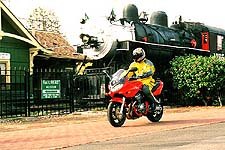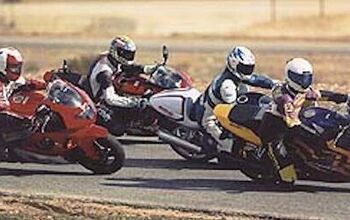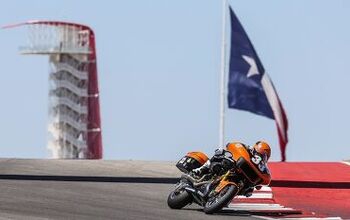Church of MO: 2000 Suzuki Bandit 600S
Therefore I say unto you, Be not anxious for your life, what ye shall eat, or what ye shall drink; nor yet for your body, what ye shall put on. Is not the life more than the food, and the body than the raiment? Behold the birds of the heaven, that they sow not, neither do they reap, nor gather into barns; and your heavenly Father feedeth them. Are not ye of much more value than they? And which of you by being anxious can add one cubit unto the measure of his life? And why are ye anxious concerning raiment? Consider the lilies of the field, how they grow; they toil not, neither do they spin: yet I say unto you, that even Solomon in all his glory was not arrayed like one of these dang Suzuki Bandits. O ye of little faith in thy brand new crispy yellow Aerostich suit, Be not therefore anxious, saying, What shall we eat? or, What shall we drink? or, Where is the cruise control? For after all these things do the Gentiles seek; for your heavenly Father knoweth that ye have need of all these things. But seek ye first his kingdom, and his righteousness; and all these things shall be added unto you. Be not therefore anxious for the morrow: for the morrow will be anxious for itself. Sufficient unto the day is the evil thereof.
2000 Suzuki Bandit 600S
A New Twist on the Original
If you’re familiar with the previous iteration of the Bandit, then you’ll immediately notice something different: the fairing. Aside from being an aesthetic improvement, it is also said to increase wind protection while housing two projector beam headlights. A 51-watt low beam and a 60-watt high beam work to guide you through the murky embraces of the night. The low beam uses the left bulb only and it puts out a surprising bit of power for only one bulb. Unfortunately, because of the design of the projector beam, unless you’re looking directly at the headlight, there is not enough intensity behind it to catch the attention of motorists who are in traffic lanes directly adjacent to the bike. We noticed more than the usual number of LA freeway drivers cutting us off, and our own unscientific observations lead us to believe the headlight is a little difficult to see at a glance. Remember, however, many of these of cut-offs could easily be due to over-aggressive staff members, so take this observation more as anecdotal evidence than as Gospel.
Still, we thought it worth mentioning because we did our own experiment and with one staffer in a car and another on the Bandit 600S, and we feel that at night the Bandit’s low beam headlight is a little difficult to see in car mirrors from certain angles. We recommend that you ride with the brights on as much as possible. Even so, from the rider’s perspective the low beam’s illumination is more than adequate and the pattern it casts on the ground is very smooth with few irregularities.
On the other side of the fairing is a new dash cluster. Equipped with stepper-motor powered dials, the speedometer and tachometer both set their limits when the ignition is initially activated, similar to the Hayabusa. The instrument lighting system is changed from incandescent bulbs to a light-emitting-diode system that draws less power while producing a similar amount of illumination.
Another advantage is that LEDs do not burn out as readily as bulbs do. In fact, the LED should last as long as the motorcycle, if not longer. Also found on the speedometer is a new liquid-crystal display that features an odometer, twin-tripmeters and a clock.
The Chassis
The frame has been completely redesigned. Most noticeable is the straight top tube and bolt-on passenger footpeg brackets. For quicker steering, rake and trail have been reduced from 25.6° to 25.0° and from 103.6mm to 98mm respectively, while the wheelbase has been increased from 56.3 inches (1430mm) to 56.7 inches (1440mm) for stability.
The front fork remains a 41mm non-adjustable piece, but the progressive spring rate was increased from 8.8 – 17.7 N/mm (Newton-meter per millimeter) to 9.81 – 19.62 N/mm with increased damping rates. Due to these new changes, Suzuki was able to reduce the oil level in each leg from 97mm to 112mm (measured from the top of the fork tubes) in order to keep fork performance as consistent as possible. Of course, the rear suspension was tweaked as well and the spring rate was increased from 62.7 N/mm to 107.87 N/mm with a slight increase in damping rates. Another addition to the shock is a free piston that separates the gas from the oil, allowing for consistent damping performance by keeping the oil at bay during aggressive riding. The rear shock features 7-way adjustable preload and 4-way adjustable damping.
The Y2K Bandit 600S is an excellent commuting motorcycle.
After adding all these go-fast goodies, Suzuki equipped the new Bandit 600S with new brakes. Dual Tokico 30.23mm dual-piston calipers replace the original 25.4mm Nissin units. The rear brakes have been upgraded to the same Tokico single-caliper found on the Hayabusa and the composition of the steel-sintered pad material has been changed. The Bandit features new 3.5 x 17 inch front and 4.5 x 17 inch rear rims as well as perhaps the single best upgrade — radial tires that use a 120/60 x 17 tire up front and 160/60 x 17 in the rear. With the use of the new 160 width tire, many more sport-oriented tires are available to the Y2K Bandit 600S rider.
The Engine
The engine receives the same pistons found on the Katana 600, allowing for an increased wrist lubrication area as well as a better ring design, both of which are said to improve sealing and reduce friction. To help keep these new pistons cool are larger oil jets that squirt more oil onto the bottoms of the pistons. To help push all this oil through the jets and refined oil passage ways is a new oil pump. The oil flow has been increased from 7.1 gallons/minute to 8.5 gallons/minute.
Feeding the engine are new Keihin CVR 32mm carburetors with a throttle position sensor (TPS) that helps keep the ignition system in tune to what throttle setting the rider has set, thereby allowing the ignition system to adjust its map settings accordingly. The TPS, along with dual maps — one for cylinders one and four and another for cylinders two and three — allows the ignition system to optimize engine performance. Also new is the addition of a pulse-secondary air injection system (PAIR System) that is said to reduce toxic emissions by adding air to the exhaust to completely combust unburned fuel. The system is purported to reduce hydrocarbons and carbon monoxide emissions as much as 50 percent.
In order to accommodate the new frame, the airbox had to be replaced. Thankfully this new unit is lighter and has more filter area. Also added is a fuel filter. The charging system has also been upgraded to a higher output alternator as well as a gradual start regulator to lessen voltage surges after high-draw situations.
The Ride
So, how does the Y2K Bandit 600S ride? Pretty good. In fact, the Bandit 600S is a vastly improved motorcycle. One of the issues that MO staffers had with previous Bandits was the amount of detectable buzz while riding at cruising speeds. While the previous Bandit 600 sent its buzz through the seat and bars, the new Bandit is much smoother, sending most of the vibration through the new fairing mounted mirrors.
The original Bandit’s mirrors vibrated as well and, unfortunately, Suzuki hasn’t done much to curb this issue. Still, while it’s a mildly annoying trait, it’s not a fatal flaw. With the new spring and damping rates, the Bandit confidently carries you through a corner.
The reduced trail and rake figures make for a quicker turning and more responsive motorcycle that is adept at strafing your local twisties. Although the bike is 15 pounds heavier, the updated geometry, suspension and tires help keep the weight gain from being noticeable. The engine is smoother and faster revving and aside from the aforementioned buzzing issue, the only other quirk that we could find with the motor is its somewhat anemic personality just after idle and at the top of its rev range. Even so, it pulled cleanly away when kept squarely within its power band and rewarded the rider with near supersport performance. Remember, that’s near supersport performance. The Bandit was never conceived to compete against the likes of true supersports like the GSX-R600.
Where the Bandit truly shines is on the street. The Y2K Bandit 600S is an excellent commuting motorcycle. Its standard seating configuration and slightly rear set footpeg positioning gave our spirited staffers confidence while weaving through thick traffic congestion. However, while the upright handlebar worked well for traffic negotiation, highway cruising and the occasional mountain road, that same footpeg positioning felt awkward for our taller staffers.
The new suspension, while harsher on the freeway then the previous version, kept the tires on the ground and performed better over the frequent potholes and surface irregularities common in most urban areas. Needless to say the front forks did experience brake dive, especially during hard braking conditions, but overall the suspension never bottomed out. Finally, a minor nit-pick we have is that although the windscreen is wider and taller, we didn’t notice any particular improvement in wind protection. However, that’s fine with us because the Bandit promotes wind-in-your face riding.
While some might lump the Bandit into the “standard” category, there really aren’t many bikes sold in the U.S that fall into the niche of the traditional standard. Perhaps the Bandit 600S should be placed into a new category, maybe a super-standard or even an ultra-commuter. If there were indeed such market niches the Suzuki Bandit 600S would be the baseline, an affordable do-it-all motorcycle with an ample dose of style and personality. The Bandit 600S cruises the freeways and boulevards with ease while can satisfy even the most discriminating of sport riders with its easy handling and performance. No, it’s not going to burn up the local track, but so what. If you want to be the next CCS fast-guy, go buy a supersport and don’t forget to save your pennies for the very high insurance premiums. If you looking for an affordable, do-it-all commuter, then take a good look at the new, 2000 Suzuki Bandit 600S.
Specification
Manufacturer : Suzuki
Model : Bandit 600S GSF600S
MSRP : $5,799
Engine : 599cc, DOHC, 16 valve, air/oil cooled,
four-stroke, inline-4
Bore/Stroke : 62.6 x 48.7 mm
Compression Ratio : 11.3:1
Carburetor : 4x Keihin CVK32
Ignition : Digital/Transistorized
Transmission : 6-speed, 530 chain
Overall Length : 2069mm (81.5 in.)
Overall Width : 760mm (29.9 in.)
Overall Height : 1218mm (48.0 in.)
Seat Height : 800mm (31.5 in.)
Ground Clearance : 135mm (5.3 in.)
Wheelbase : 1433mm (56.4 in.)
Dry Weight : 208kg (459 lbs.)
Suspension, Front : 41mm, telescopic, oil damped
Suspension, Rear : Link-type, 4-way adjustable
rebound damping,
7-way adjustable preload
Brakes, Front : Dual 290mm hydraulic discs
Brakes, Rear : Single hydraulic disc
Tires, Front : 120/60-ZR17
Tires, Rear : 160/60-ZR17
Fuel Tank Capacity: 20.0 liter (5.3 gal.)
Color: Black, Red
More by John Burns





































Comments
Join the conversation
I loved my 07 Bandit 1250S. I've owned several motorcycles over the years and have ridden just about every type of bike out there. My Bandit that I picked up for $4800 with 3,500 miles in 2010 was my favorite. Was an excellent commuter and made several trips to the Tail of the Dragon.0 https://uploads.disquscdn.c...
Decent bike and I miss the relative simplicity of twenty years past, but damn, the bikes today are so much better. You all have heard me praise my 2001 ZRX, and I think it still looks great, but just like this 600, it doesn't really compete with today's marvels of engineering (sometimes ugly, often expensive, marvels, but marvels all the same).